Proper inspection and maintenance ensure your fire extinguishers are ready for use in an emergency
Fire extinguishers are the first line of defense against small fires, and they must remain fully charged or pressurized to be effective in an emergency. But many building owners responsible for maintaining extinguishers and staying code-compliant aren’t sure when a fire extinguisher recharge is necessary or how to do it. This guide provides the answers you need, detailing the National Fire Protection Association’s (NFPA) maintenance intervals specified in NFPA 10: Standard for Portable Fire Extinguishers.
Let’s take a look at the guidelines for recharging fire extinguishers, including:
- When and why extinguishers need to be recharged
- The process of recharging fire extinguishers
- Deciding whether to recharge or replace your extinguishers
If you are looking to buy fire extinguishers, feel free to check out our online selection.
Why do fire extinguishers need to be recharged?
You wouldn’t let your car go its entire lifetime without routine maintenance and expect it to always work correctly.
The same principle applies to fire extinguishers. Just as your car needs routine maintenance, your fire extinguishers need upkeep to work as intended in an emergency. This maintenance includes everything from replacing the extinguishing agents that diminish over time or due to use, to disassembling and reassembling extinguishers to ensure every component is in working condition.
A fire extinguisher must be regularly checked to ensure there is always enough extinguishing agent to control a fire in an emergency.
Below is a list of specific events that indicate that it’s time to recharge a fire extinguisher:
- The fire extinguisher has reached its internal examination or hydrostatic test interval set by NFPA 10.
- The fire extinguisher has been used/discharged.
- An inspection shows that a fire extinguisher is damaged or depleted.
When to get a recharge
First and foremost, a fire extinguisher needs to be recharged if it has been used. Whether it was employed to suppress a fire, used in an act of vandalism, or accidentally discharged, the extinguishing agent needs to be replaced. And again, NFPA 10 requires a fire extinguisher recharge after any use or if an inspection turns up an issue:
From the 2022 edition of NFPA 10
7.8.1.1 All rechargeable-type fire extinguishers shall be recharged after any use or when the need is indicated by an inspection or servicing.
NFPA 10 also stipulates that fire extinguishers must be visually inspected once a month:
From the 2022 edition of NFPA 10
7.2.1.2* Fire extinguishers and Class D extinguishing agents shall be inspected either manually or by means of an electronic monitoring device/system at intervals not exceeding 31 days.
7.2.1.2.1 Fire extinguishers and Class D extinguishing agents shall be inspected at least once per calendar month.
There are certain situations that require fire extinguishers to be inspected at a more frequent rate, including if a property has a frequent history of fires, there is a good possibility that extinguishers may be damaged (for example, forklift operations in a storage facility could impact extinguishers), they’re located in a high-crime area where extinguishers may be vandalized or stolen, and more. NFPA 10 provides a full list of factors that call for checkups more often:
From the 2022 edition of NFPA 10
7.2.1.3* Fire extinguishers and Class D extinguishing agents shall be manually inspected daily or weekly when conditions exist that indicate the need for more frequent inspections.
A.7.2.1.3 Inspections should be more frequent if any of the following conditions exist:
(1) High frequency of fires in the past
(2) Severe hazards
(3) Susceptibility to tampering, vandalism, or malicious mischief
(4) Possibility of, or history of, theft of fire extinguishers
(5) Locations that make fire extinguishers susceptible to mechanical injury
(6) Possibility of visible or physical obstructions
(7) Exposure to abnormal temperatures or corrosive atmospheres
(8) Characteristics of fire extinguishers, such as susceptibility to leakage
During these inspections, one of the most important things to look for is whether the fire extinguisher is pressurized within its acceptable range. NFPA 10 lists everything that is included in a monthly visual inspection. If deficiencies are found, they need to be fixed—which may include a fire extinguisher recharge [these conditions are bolded below]:
From the 2022 edition of NFPA 10 [QRFS Emphasis Added]
7.2.2 Inspection Procedures. Periodic inspection or electronic monitoring of fire extinguishers shall include a check of at least the following items:
(1) Location in designated place
(2) Visibility of the extinguisher or means of indicating the extinguisher location
(3) Access to the extinguisher
(4) Pressure gauge reading or indicator in the operable range or position
(5) Fullness determined by weighing or hefting
(6) Condition of tires, wheels, carriage, hose, and nozzle for wheeled extinguishers
(7) Indicator for non-rechargeable extinguishers using push-to-test pressure indicators
When inspecting the pressure gauge, look at the location of the pressure needle. If the needle is within the green zone of the pressure gauge, the fire extinguisher is properly pressurized to meet manufacturer specifications. The pressure gauge also lists the proper pressure requirement for that extinguisher.
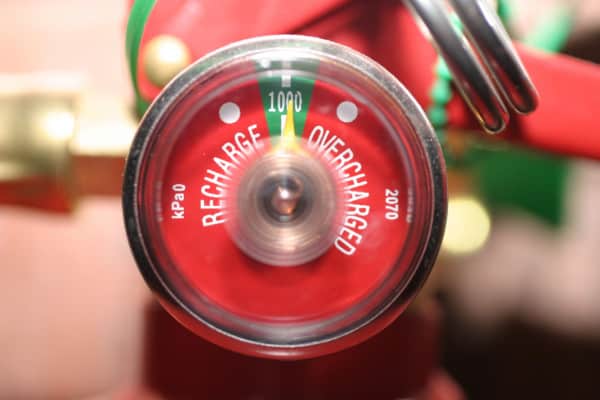
If the extinguisher needs to be recharged, the needle will be located outside of the green zone and in the “recharge” portion of the pressure gauge.
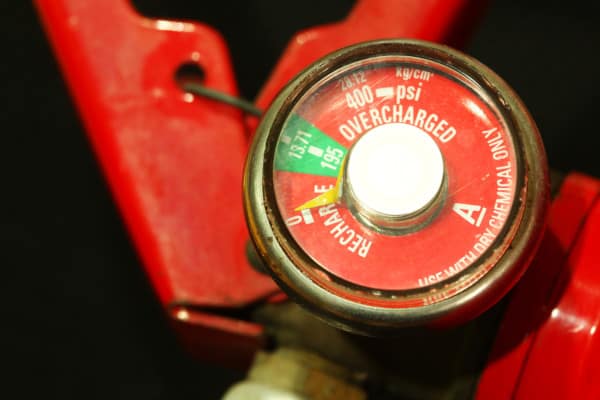
NFPA 10 requires fire extinguishers to undergo annual maintenance in addition to monthly visual inspections, as well as maintenance when there is a problem or a longer-interval hydrostatic test is required:
From the 2022 edition of NFPA 10
7.3.1.1 Fire extinguishers shall be subjected to maintenance at intervals of not more than 1 year, at the time of hydrostatic test, or when specifically indicated by an inspection discrepancy or electronic notification.
When performing annual maintenance, the following is done in addition to the requirements specified in monthly inspections (one of those is also completed during this annual maintenance):
- External examination looking for any obvious damage, corrosion, or nozzle blockage.
- Remove the tamper seal by pulling the pin to ensure proper use. Replace the tamper seal immediately afterward.
Beyond monthly inspections and annual maintenance, NFPA 10 sets intervals at which fire extinguishers must be internally inspected and hydrostatically tested. These intervals vary depending on what type of extinguishing agent is used and the manner in which they are stored.
During the internal inspection, the fire extinguisher is taken apart completely. All components are inspected and cleaned, and any broken pieces are replaced. Once this is completed, the extinguisher is put back together and placed back in service. These internal inspections and maintenance can vary from once every year to once every six years, depending on the exact type of extinguisher:
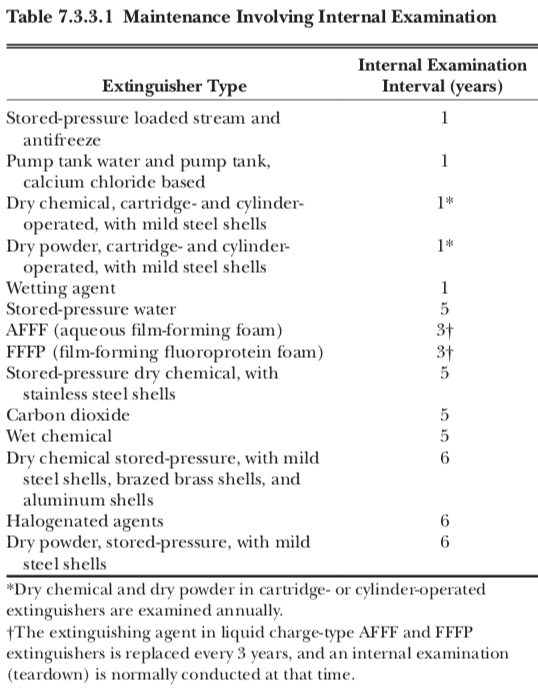
Hydrostatic testing is also performed at intervals set by NFPA 10 and is based upon the type of extinguishing agent. During the test, extinguishers are pressurized with water or another non-compressible fluid to a specified PSI for a minimum of 30 seconds. While pressurized, the extinguisher is inspected to ensure the integrity of the cylinder, check for deformations, and ensure there aren’t leaks.
The cost of hydrostatic testing varies by cylinder size and extinguishing agent type. For a 20LB ABC Dry Chemical extinguisher, for example, you can expect to pay between about $40 and $55, whereas hydrostatically testing an extinguisher designed to fight Class D metal fires might run about $160.
If the cost of a new extinguisher is comparable or less than the cost of a hydrostatic test, replacing the old extinguisher with a new one is a good option. Table 8.3.1 of NFPA 10 lists the intervals for hydrostatic testing:
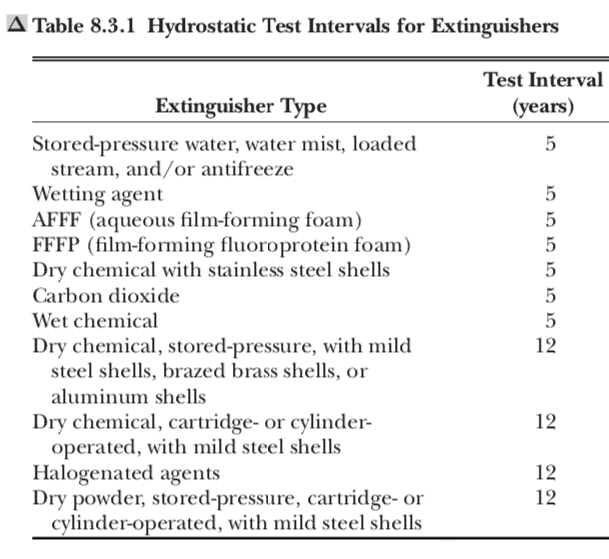
If you aren’t sure what type of extinguisher you have, check out some of our other resources:
- “What Does the Number on a Fire Extinguisher Mean?”
- “Ultimate Guide to Fire Extinguisher Classes: Servicing and Use”
The most common fire extinguisher is the ABC dry chemical type, which requires recharging and internal inspection 6 years after the manufacture date, and hydrostatic testing 12 years after the manufacture date.
How are fire extinguishers recharged?
When it is determined that a fire extinguisher needs to be recharged, call a fire extinguisher servicing company to have it done. They will send a trained technician to service your extinguishers on-site or take them to a facility to perform the required maintenance.
Again, rates for a fire extinguisher recharge vary based on the type of extinguisher and where you live. But to recharge a 20 LB ABC dry chemical fire extinguisher, you can expect to pay between around $45 to $50, whereas a 2.5 LB ABC might be around $20, and an extinguisher dealing with Class D fires might be $140. It can be more efficient to simply replace certain fire extinguishers rather than recharging them.
To understand how recharging works, watch this video of a service technician demonstrating the process with a dry chemical extinguisher:
Do all fire extinguishers need to be recharged?
Nope. Some fire extinguishers are single-use, and therefore classified as non-rechargeable; once they are discharged, they need to be disposed of and replaced. There are some key physical differences between disposable and rechargeable fire extinguishers that differentiate them:
Disposable fire extinguishers typically have the following:
- A plastic discharge head
- A pressure gauge that simply reads full/empty
- A life span of 12 years from the manufacture date before they must be replaced.
- The extinguisher should be clearly labeled as non-rechargeable
Rechargeable fire extinguishers typically have the following:
- They often (though not always) have metal discharge head
- A pressure gauge that reads undercharged/overcharged and a full zone, which is the green zone on the gauge
- The extinguisher should be clearly labeled as rechargeable
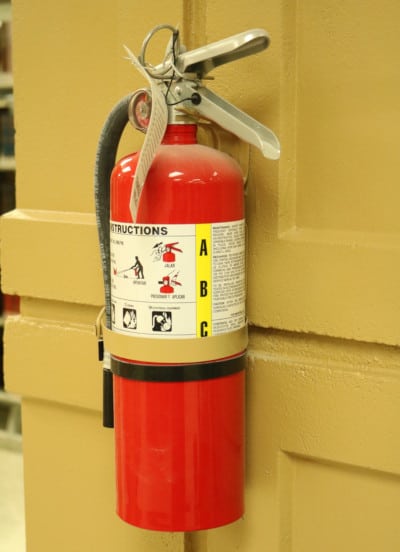
When to replace your rechargeable fire extinguisher:
- Extinguisher size: It can be cost-effective to simply replace smaller fire extinguishers instead of having them recharged.
- Condition of the extinguisher shell: If the shell shows signs of cracks, dents, or corrosion, or it’s got an unreadable label.
- Discharge hose/handle condition: If the handle is wobbly or the discharge hose shows signs of cracks or rips, or it’s clogged.
- Canister loses pressure: If the canister continuously loses its pressure, the shell may have lost integrity and a replacement is in order.
If you’re in the market for new extinguishers, we have you covered
A fire extinguisher recharge is an important aspect of maintenance that ensures an extinguisher will work in an emergency. NFPA 10 takes the guesswork out of the equation, providing specific guidelines for hydrostatic testing, inspection, maintenance, and recharging.
And remember, take the cost and type of extinguisher into consideration when deciding to hydrostatically test or recharge your extinguisher. It may be cheaper or easier to replace one.
QRFS has access to almost any fire extinguisher you could need, including wheeled on/offshore models, dry-chemical, halotron, mist and foam systems, nitrogen-operated and dry-powder models, and more. If you’re looking for an extinguisher that isn’t in our online inventory, call us at +1 (888) 361-6662 or email support@qrfs.com.
Otherwise, check out our online selection of ABC and BC dry chemical and CO2 extinguishers. We also stock fire extinguisher cabinets, brackets, covers, and other accessories.
This blog was originally posted at blog.qrfs.com. Check us out at Facebook.com/QuickResponseFireSupply or on Twitter @QuickResponseFS.


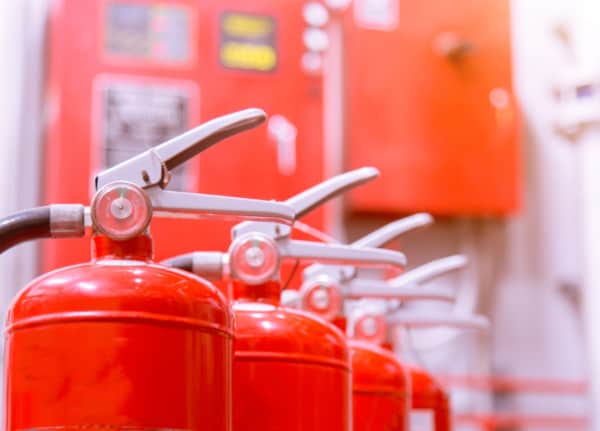

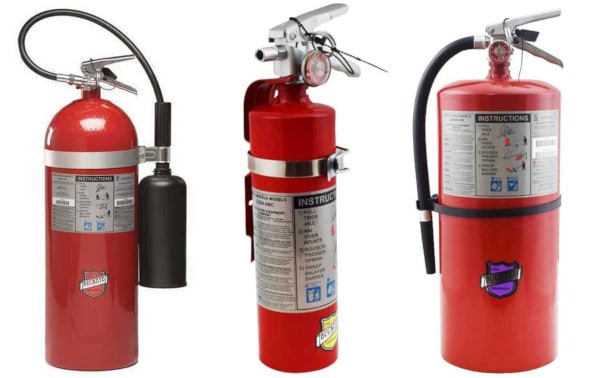
My boss told me that we will move to the office next door and there are a few things left before we can be able to move out such as checking the security and electric systems. I like how you mentioned that inspecting fire extinguishers means that they will be taken apart. Thanks for sharing this article, I will recommend my boss to hire a professional company that can properly inspect the fire extinguishers because they look old.
Nice guidelines! Thanks for sharing.
What if the gauge is on the left side, on the line between green and red? Doesn’t that mean it is losing pressure?
Yes, likely that it has lost some pressure. If it moves into the red, you need to recharge or replace it.
Hello!
Im interested in your services/products.
‘
How do you charge for refill? Can we receive a pricing sheet.
Also, are you a net vendor with our company?
‘
Thank you!
Juan, thank you for reaching out. We will have someone from our QRFS Customer Support Team contact you.
After a small chemical experiment mishap resulted in a minor fire in his laboratory, my brother realized the importance of having appropriate fire safety equipment on hand. To ensure the safety of both himself and his research, he’s actively searching for dry chemical extinguishers as they are versatile and effective in suppressing various types of fires, making them an ideal choice for his lab’s needs. I mean, I hope he educated himself first about how the needle will be outside of the green zone and in the “recharge” area of the pressure gauge if the extinguisher needs to be recharged first among other things though. Thanks for this
I need some clarification on the credibility of the Gauge on a Stored Pressurized Fire Extinguisher, without opening the Fire Extinguisher.
How can I confirm that the Gauge Pin is not stuck in a charge position, but it still lost pressure?
Nico — you should contact a qualified fire extinguisher servicing company and have them assess the extinguisher if you suspect it isn’t charged and the gauge is off. Thanks for reading.